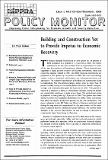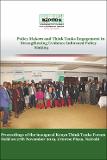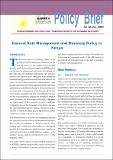| dc.date.accessioned | 2021-07-02T08:21:03Z | |
| dc.date.available | 2021-07-02T08:21:03Z | |
| dc.date.issued | 2003 | |
| dc.identifier.uri | http://repository.kippra.or.ke/handle/123456789/3019 | |
| dc.description.abstract | One of the Government of
Kenya's policy objectives is
to put in place sound
macroeconomic policies to achieve
economic and social targets. Fiscal
and monetary policies are two
instruments, among others, whose
design has a critical bearing on the
performance of the economy. A key
consideration of the stance of
monetary and fiscal policies that the
Government should put in place is
the potential output of the economy
and, by implication, the output gap.
Potential output is the maximum
output the economy can sustain
without generating a rise in inflation.
Output gap on the other hand is the
difference between the actual
economic output and the nation's
output potential. This gap is an
important benchmark for assessing
inflationary or disinflation pressur es
in the economy. Measur ing the level
of the economy's potential output
and output gap therefore helps in
identifying sustainable noninflationary
growth and in assessing
the most appropriate macroeconomic
policies, specifically the most
appropriate fiscal and monetary
policies. | en |
| dc.language.iso | en | en |
| dc.publisher | The Kenya Institute for Public Policy Research and Analysis (KIPPRA) | en |
| dc.relation.ispartofseries | Policy Monitor Issue 1, No.2 2003; | |
| dc.subject | Fiscal policies | en |
| dc.subject | Monetary policies | en |
| dc.subject | Economic recovery | en |
| dc.subject | Infrastructure Financing | en |
| dc.subject | Economic growth | en |
| dc.title | Policy Monitor, Issue 1 No. 2, October-December 2003 on Building and Construction Yet to Provide Impetus to Economic Recovery | en |
| dc.type | KIPPRA Publications | en |
| ppr.contributor.author | The Kenya Institute for Public Policy Research and Analysis (KIPPRA) | en |




